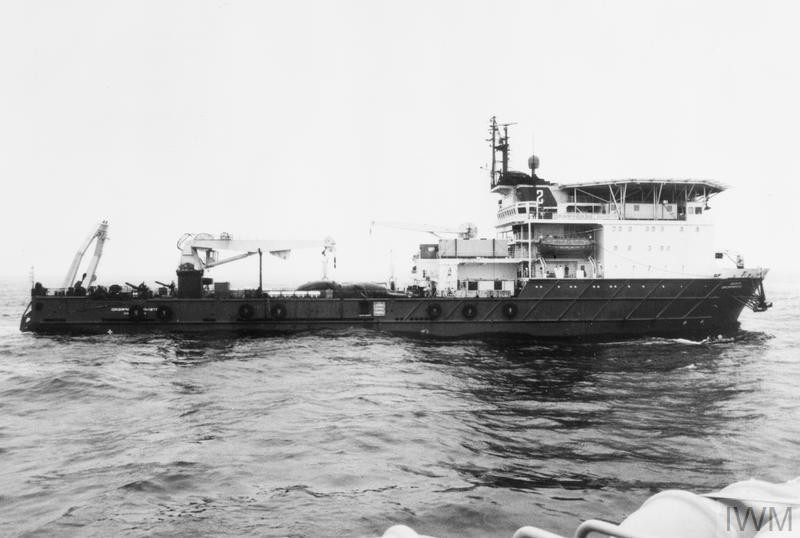Friday 16 April 1982 saw Battle Group Commander Admiral Sandy Woodward fly from his flagship, carrier HMS Hermes, to amphibious assault ship HMS Fearless for initial discussions with Commodore Amphibious Warfare Mike Clapp and the Commander of 3 Cdo Bde Brig Julian Thompson about what lay ahead.
By evening on 16 April the Carrier Battle Group had reached Ascension. The ships had been working up their air wings en route to the island, and the helicopters in particular were put to the test at Ascension when an intense period of moving stores and equipment required a gruelling programme of vertical replenishment (vertrep) flights.
Several more support ships left their ports in the UK on 16 April.
Small fleet tanker RFA Blue Rover sailed from Portsmouth, while offshore support vessel Stena Seaspread, complete with heavy machine shop for her role as a repair ship, also headed out to take her place as part of the Tug, Repair and Logistic Area (TRALA) off the Falkland Islands.
Two chartered tankers also sailed south – British Tamar departed from Milford Haven in Wales while British Trent loaded up at Fawley in Southampton Water, the Isle of Grain and Gosport before sailing.
Ocean-going tug RMAS Typhoon, the first ship to leave the UK after the Argentine invasion on 2 April, reached Ascension on 16 April, as did RFA Resource, as part of the Carrier Battle Group.
Back in Gibraltar, the educational cruise ship SS Uganda, which had already been worked on while at sea after dropping her passengers in Naples, became the focus of a remarkable example of high-speed conversion.
Entering Number 2 Dry Dock on 16 April, Uganda was boarded by hundreds of dockyard workers who pulled out all the stops to convert the liner into a hospital ship in just three days.
The process was made slightly easier because of the dormitory-style accommodation, but there was still a great deal of intrusive work to carry out, such as cutting decks, rerouting pipes and fitting a 40-ton helicopter flight deck with a link ramp to transfer patients.
One problem the workforce encountered was a shortage of red paint – stores had to be scoured to find sufficient paint to mark Uganda with the red crosses on her white paintwork which met with the requirements of the Geneva Convention.
* These posts can only give a brief sense of what was a complex and fast-moving situation 40 years ago, and cannot cover the involvement of every ship, squadron and unit in detail – for a much more comprehensive account see naval-history.net at https://www.naval-history.net/NAVAL1982FALKLANDS.htm
Today’s image from the Imperial War Museum collection (© IWM FKD 42) shows repair ship MSV Stena Seaspread on passage to the South Atlantic.
